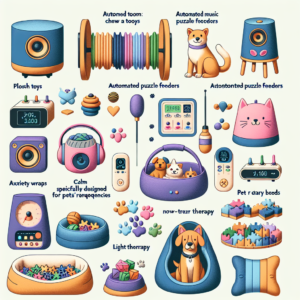- Key Takeaways: Enhancing Comfort for Senior Pets
- Common Causes of Pain in Aging Pets
- Detecting Signs of Discomfort in Senior Pets
- Overview of Pain Management Wearables
- How Wearable Technology Provides Pain Relief
- Electric Pulse Pain Relief Collars
- Therapeutic Orthopedic Wearables
- Smart Monitoring Devices for Continuous Care
- Choosing the Right Wearable for Your Pet
- Training Pets to Accept Wearables
- Monitoring and Adjusting Wearable Use
- Maintaining Activity and Mobility
- Creating a Supportive Home Environment
- Can wearables completely eliminate pain in senior pets?
- Are there any side effects associated with using pain management wearables?
- How long do pets typically need to use pain management wearables?
- Can pain management wearables be used alongside medication?
- Are pain management wearables suitable for all breeds and sizes of pets?

Key Takeaways: Enhancing Comfort for Senior Pets
- Identify the common causes of pain in senior pets, such as arthritis and degenerative joint disease.
- Recognize the signs of discomfort in your aging pet to provide timely care.
- Discover how pain management wearables can revolutionize the way we alleviate pain in senior pets.
- Learn about different types of pain management wearables, including electric pulse collars and therapeutic braces.
- Understand how to integrate wearables into your pet’s life for improved health and happiness.
Understanding Senior Pet Pain
As our beloved pets enter their golden years, they’re not just gaining wisdom but often, chronic pain as well. It’s a sad reality that the wear and tear of a lifetime can lead to conditions like arthritis, which can significantly dampen their zest for life. But it’s not just arthritis; there are a myriad of issues that can cause pain in senior pets. Knowing what these are is the first step to managing their discomfort and ensuring they enjoy their later years to the fullest.
Common Causes of Pain in Aging Pets
When it comes to understanding pain in our senior pets, it’s crucial to know the usual suspects. Arthritis is the most common, but other conditions like hip dysplasia, dental disease, and even cancer can cause chronic pain. Each of these conditions has a different way of affecting your pet, but they all result in one thing: discomfort that needs managing.
For example, arthritis can cause your pet’s joints to become inflamed and tender, making it painful to move around. Hip dysplasia, on the other hand, is a genetic condition that leads to abnormal joint structure and can result in severe pain during movement. Dental disease might not be as obvious, but it can cause significant oral pain, affecting your pet’s ability to eat. And while cancer might be less common, it’s a serious condition that can lead to pain in various parts of the body.
Detecting Signs of Discomfort in Senior Pets
Now, because pets can’t tell us when they’re in pain, we need to be their advocates and learn to spot the signs. A change in behavior is often the first clue. Maybe your once playful pup is now reluctant to climb stairs or jump onto their favorite couch. Or perhaps your cat isn’t grooming themselves as meticulously as before. These subtle changes can be your pet’s way of saying, “I hurt.”
Here are some other signs to watch for:
- Limping or favoring one leg over others
- Difficulty standing up after lying down
- Decreased activity or less interest in play
- Whining, howling, or other vocalizations
- Licking, chewing, or biting areas that may be painful
When you notice these changes, it’s time to consult your veterinarian. They can help you understand what’s happening and work with you to manage your pet’s pain effectively.

Revolutionizing Pain Relief with Wearables
Enter pain management wearables: the cutting-edge solution that’s changing the game for senior pets. These devices are designed to offer non-invasive pain relief, allowing our pets to move more freely and with less discomfort. But what exactly are these wearables, and how do they work? Let’s dive in.
Overview of Pain Management Wearables
Pain management wearables are devices that your pet can wear, which help to reduce pain and improve mobility. They come in various forms, such as collars, braces, and even smart devices that monitor health. The beauty of these wearables is that they’re designed to be comfortable and, in many cases, can be worn throughout the day and night for consistent pain relief.
How Wearable Technology Provides Pain Relief
So how do these wearables provide relief? They often use methods like electric pulses, heat therapy, or compression to target pain. For instance, a wearable might emit a gentle electric pulse that stimulates nerves and reduces pain signals sent to the brain. Heat therapy can help to soothe stiff joints and muscles, while compression can provide support and reduce swelling.
Most importantly, these wearables are developed with pet safety and comfort in mind. They are usually adjustable to ensure a perfect fit and made from materials that won’t irritate your pet’s skin.
Electric Pulse Pain Relief Collars
Let’s talk about electric pulse pain relief collars. These nifty devices work through a method called Transcutaneous Electrical Nerve Stimulation (TENS). They deliver small, safe electric pulses to your pet’s skin, which can help to block pain signals from reaching the brain. Imagine it as a gentle buzz that distracts your pet from the pain they’re feeling in their joints or muscles. It’s like when you rub your elbow after knocking it on a door frame; the rubbing sensation helps to ease the pain. That’s the basic principle behind these collars.
Therapeutic Orthopedic Wearables
Moving on to therapeutic orthopedic wearables, these are designed to provide support and stability to your pet’s joints. They’re especially helpful for conditions like arthritis or hip dysplasia. Think of them as a snug hug around your pet’s aching joints, providing a comforting pressure that can help reduce inflammation and pain. They’re often made with materials that retain heat, further soothing sore spots.
Smart Monitoring Devices for Continuous Care
Then there are smart monitoring devices. These wearables are a bit like fitness trackers for pets. They can monitor your pet’s activity levels, sleep patterns, and even track their pain levels over time. This information can be invaluable in managing chronic pain, as it helps you and your vet understand how your pet is doing on a day-to-day basis. You’ll know if a certain activity increases their pain or if they’re getting the rest they need to recover.

Integrating Wearables into Your Pet’s Life
Now that you’re familiar with the types of wearables available, it’s time to consider how to integrate them into your pet’s routine. This is a crucial step, as the right wearable used correctly can significantly enhance your pet’s quality of life.
Choosing the Right Wearable for Your Pet
Choosing the right wearable for your pet starts with a conversation with your vet. Together, you can determine which type of wearable would be most beneficial based on your pet’s specific condition and needs. It’s also essential to consider your pet’s size, fur type, and level of activity when selecting a wearable. You want something that’s going to be comfortable for them to wear and that won’t interfere with their daily activities.
Training Pets to Accept Wearables
Training your pet to accept wearables is all about patience and positive reinforcement. Start by introducing the wearable for short periods while offering lots of praise and treats. Gradually increase the time they wear it as they become more comfortable. It’s important to ensure the wearable is fitted correctly to avoid any discomfort that could cause your pet to reject it.
Monitoring and Adjusting Wearable Use
Once your pet is wearing their new pain management device, keep a close eye on them to see how they’re responding. If you notice any signs of irritation or discomfort, it may be necessary to adjust the fit or try a different type of wearable. Remember, the goal is to make your pet more comfortable, not to add to their distress.
Achieving a Happier, Healthier Senior Pet
Integrating pain management wearables into your senior pet’s life is just one part of a holistic approach to their health and happiness. To truly make a difference, you’ll need to consider their overall lifestyle, from diet and exercise to their living environment.
Maintaining Activity and Mobility
Maintaining activity and mobility in senior pets is crucial for their physical and mental health. While it’s important to adjust expectations based on their capabilities, keeping them moving is key. Regular, gentle exercise can help to keep their joints limber and manage weight, which is especially important for pets with arthritis.
Creating a Supportive Home Environment
Creating a supportive home environment means making adaptations to your home that can help your senior pet navigate their space without pain. This could include adding ramps or steps to help them reach their favorite spots or providing orthopedic bedding to support their joints while they rest. It’s all about making their daily life as comfortable as possible.
In conclusion, managing chronic pain in senior pets is a multifaceted endeavor that requires attention to detail, patience, and love. With the right pain management wearables and a supportive environment, you can help your senior pet live a comfortable and joyful life. Always work closely with your vet to tailor a pain management plan that suits your pet’s individual needs, and you’ll be well on your way to enhancing their golden years.

Frequently Asked Questions
When it comes to pain management wearables for senior pets, pet owners often have a number of questions. Let’s address some of the most common concerns to provide clarity and peace of mind.
Can wearables completely eliminate pain in senior pets?
While pain management wearables can significantly reduce discomfort in senior pets, they may not eliminate pain entirely. These devices are designed to work as part of a broader pain management plan, which might include medication, diet, and environmental modifications. The goal is to minimize pain to a level where your pet can enjoy daily activities with more comfort and less distress.
Are there any side effects associated with using pain management wearables?
Most pain management wearables are designed to be safe and non-invasive. However, it’s important to ensure they’re used correctly. Incorrect use or improper fitting can lead to skin irritation or discomfort. Always follow the manufacturer’s instructions and your veterinarian’s guidance when using these devices.
How long do pets typically need to use pain management wearables?
The duration of use for pain management wearables varies depending on the individual pet and the severity of their condition. Some pets may benefit from wearing them for short periods during flare-ups of pain, while others might need them for ongoing support. Your veterinarian can help you determine the right schedule for your pet.
Can pain management wearables be used alongside medication?
Yes, pain management wearables can often be used in conjunction with medication. In fact, combining wearables with medication can lead to better pain control for your pet. It’s crucial to consult with your vet before starting any new treatment to ensure it’s safe and appropriate for your pet’s specific health needs.
Are pain management wearables suitable for all breeds and sizes of pets?
Pain management wearables come in various sizes and designs to accommodate different breeds and sizes of pets. It’s essential to choose a wearable that’s appropriately sized and designed for your pet to ensure effectiveness and comfort. Some wearables are specifically tailored for certain conditions and body types, so it’s worth discussing options with your veterinarian.
Ultimately, pain management wearables represent a significant advancement in the care of senior pets. By addressing pain in a targeted and non-invasive manner, these devices can greatly enhance the quality of life for our aging companions. With careful selection, proper use, and regular monitoring, pain management wearables can be a valuable addition to your senior pet’s healthcare regimen.



Leave a Reply